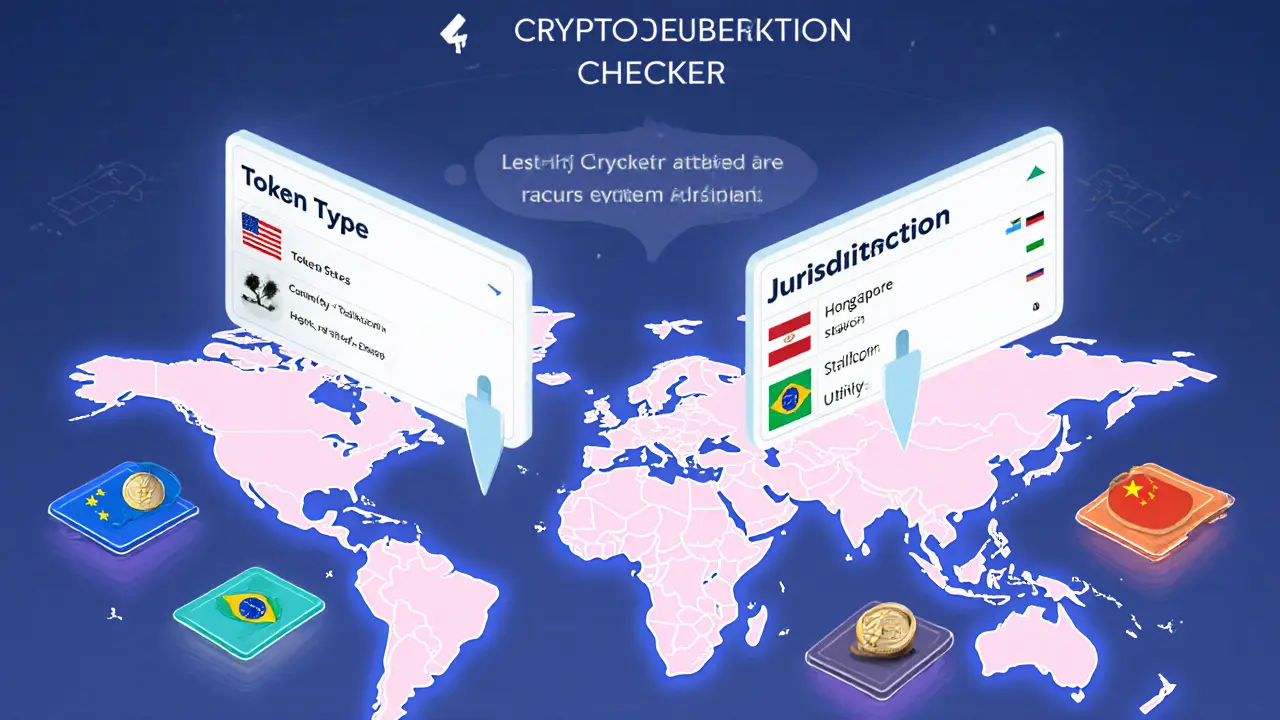International Securities Laws for Crypto: 2025 Compliance Guide

Crypto Regulatory Jurisdiction Checker
Regulatory Requirements
Jurisdiction Overview
United States
SEC and CFTC oversight with GENIUS Act and CLARITY Act.
Security Commodity StablecoinEuropean Union
MiCAR regulation applies to crypto-asset service providers.
Security Commodity StablecoinSingapore
MAS licensing and regulatory sandbox for innovation.
Security Commodity StablecoinHong Kong
SFC and HKMA oversight with draft stablecoin rules.
Security Commodity StablecoinBrazil
Central Bank supervision with fraud prevention focus.
Security Commodity StablecoinChina
Complete prohibition on crypto exchanges and trading.
ProhibitedInternational securities laws for cryptocurrency are the set of rules that determine when a digital token counts as a security and how governments enforce investor protection across borders. As we move through 2025, the patchwork of national rules is finally snapping together, giving businesses a clearer road map for crypto regulation. Below you’ll find a practical walk‑through of the biggest jurisdictional shifts, the key U.S. statutes, Asian licensing trends, the EU’s MiCAR rollout, and what the future looks like for cross‑border compliance.
Why the regulatory landscape changed in 2025
For years, regulators relied on case‑by‑case enforcement, which left token issuers guessing whether the Howey test applied. Two forces pushed the tide toward legislation:
- Institutional demand for certainty - banks and asset managers stopped flirting with crypto until rules were written.
- Political turnover - the U.S. administration elected in 2024 pledged to replace ‘regulation by enforcement’ with transparent statutes.
The result? A surge of bills, licensing regimes, and inter‑agency agreements that, while still evolving, give market participants a concrete compliance checklist.
U.S. federal framework: the GENIUS Act, CLARITY Act, and Project Crypto
GENIUS Act established the first federal rulebook for stablecoins, requiring full‑reserve backing and monthly audits passed in early 2025. Its main points are:
- Only issuers approved by the SEC or foreign entities registered in the U.S. may create payment stablecoins.
- Each token must be 1:1 backed by cash or highly liquid assets.
- Monthly third‑party audits and AML/KYC procedures are mandatory.
- Public disclosure of reserve composition and risk factors is required.
The pending CLARITY Act clarifies that the CFTC has primary jurisdiction over digital commodities while the SEC handles digital securities will codify the de‑facto split that emerged from the 2023 agency dispute. In short, if a token is deemed a commodity - think Bitcoin or a fully decentralized utility token - the CFTC steps in. If it meets the Howey criteria, the SEC takes charge.
On July 31, 2025, SEC Chair Paul Atkins launched Project Crypto to rewrite the agency’s approach to digital assets. The headline takeaway: “most crypto assets are not securities.” Staff are now drafting a decision‑tree that lets issuers self‑classify, with safe‑harbor exemptions for truly decentralized projects. This shift alone cuts compliance costs for dozens of startups that had been over‑engineering their token sale structures.
Bank participation: the OCC’s 2025 interpretive letter
Office of the Comptroller of the Currency (OCC) issued Interpretive Letter 1183, allowing national banks to hold crypto assets and provide custody services on March 7, 2025. The letter boots the 2021 non‑objection process, meaning banks no longer need a separate regulator’s sign‑off to engage in crypto‑related activities. In practice, this opens the door for a wave of bank‑backed wallets, stablecoin custodial accounts, and even participation in independent node verification networks.
Asian regulatory models: Singapore, Hong Kong, and beyond
Asia’s financial hubs have taken a more prescriptive but business‑friendly route. Singapore has a rigorous licensing regime for crypto service providers and a finalized stablecoin framework that requires full reserve backing similar to the GENIUS Act but with a lighter reporting cadence. The Monetary Authority of Singapore (MAS) also offers a sandbox for tokenized securities, encouraging innovation while monitoring systemic risk.
Hong Kong SAR has rolled out a comprehensive licensing regime covering exchanges, OTC desks, and custodians, and is drafting its own stablecoin rules. The city positions itself as a regional hub for crypto derivatives, balancing investor protection with a desire to attract global capital.
These models show that clear licensing, reserve requirements, and sandbox flexibility can coexist - a blueprint many regulators are now eyeing.

European Union’s MiCAR: the first pan‑EU crypto law
The Markets in Crypto‑Assets Regulation (MiCAR) entered force in May 2023 and will be fully operational by January 2026. Its key mandates include:
- All crypto‑asset service providers must obtain an EU‑wide licence.
- Stablecoin issuers need to publish a white‑paper detailing reserve assets and governance.
- Transactions above €1,000 require sender and beneficiary identification; self‑hosted wallets holding >€1,000 must verify ownership before any transfer.
During the transitional period, many European firms are scrambling to align internal AML/KYC systems with MiCAR’s granular data‑capture rules. The uncertainty has already prompted some fintechs to relocate to Singapore or Hong Kong for a more predictable environment.
Other global approaches: Brazil’s Cryptoassets Act and China’s ban
Brazil’s Cryptoassets Act places the Central Bank in charge of supervising crypto firms, focusing on fraud prevention and AML compliance (June 2023). The law defines criminal conduct related to crypto scams and sets steep penalties for non‑compliant service providers.
China, by contrast, maintains an absolute prohibition on crypto exchanges, trading, and mining. The country’s stance illustrates the extremes of regulatory philosophy - from full integration to outright ban - and serves as a cautionary tale for markets that ignore compliance.
Comparative snapshot of major regimes
| Jurisdiction | Primary Regulator(s) | Security vs Commodity Split | Stablecoin Rules | Licensing Requirement |
|---|---|---|---|---|
| United States | SEC, CFTC, OCC | SEC: securities; CFTC: commodities (pending CLARITY Act) | GENIUS Act - 1:1 reserve, monthly audits | Federal (GENIUS/CLARITY) + State money‑transmitter licenses |
| European Union | European Commission, ESMA | MiCAR: token classification based on function; no separate commodity regulator | Full reserve & public white‑paper required | EU‑wide crypto‑asset service provider licence |
| Singapore | MAS | MAS‑defined securities vs utility tokens; CFTC‑style commodity split not applied | Reserve backing required; reporting annually | MAS licence for exchanges, custodians, stablecoin issuers |
| Hong Kong | SFC, HKMA | Security classification follows Howey; commodity tokens largely unregulated | Drafting stablecoin framework (reserve disclosure) | Licensing for exchanges, OTC, custodians |
| Brazil | Central Bank of Brazil | Crypto assets treated as non‑securities unless part of a tokenized security offering | Reserve transparency mandated for stablecoins | National crypto‑service provider registration |
| China | People's Bank of China | All crypto assets banned - no security/commodity classification | Not applicable - outright prohibition | None - activities illegal |
Practical steps for cross‑border compliance in 2025
Even with clearer laws, managing a multinational crypto operation is a juggling act. Follow this checklist to stay on the right side of regulators:
- Map your token classification. Use the SEC’s upcoming Project Crypto decision‑tree for U.S. markets, MiCAR’s functional test for the EU, and local licensing guides for Asia.
- Secure the appropriate licence(s). In the U.S., file for a federal charter (GENIUS/CLARITY) and the necessary state money‑transmitter licenses. In the EU, apply for the MiCAR crypto‑asset service provider licence before Jan2026.
- Implement reserve management.
- For stablecoins, set up a segregated account with a top‑tier bank that can provide monthly audited statements.
- Store audit reports in a tamper‑proof ledger to ease regulator review. - Build AML/KYC workflows that capture sender/beneficiary data at the €1,000 threshold (MiCAR) or any amount for U.S. stablecoin issuers.
- Adopt a multi‑jurisdiction tax strategy. Remember the IRS still treats crypto as property - track every purchase, sale, and swap for capital gains reporting.
- Prepare for retroactive compliance. Some jurisdictions (e.g., the EU) may back‑date certain reporting obligations once licences are granted.
- Engage local counsel. The classification nuance between a security and a commodity often hinges on subtle factual differences that only regional experts can spot.
Looking ahead: coordination and standardization
Analysts from the PwC Global Crypto Regulation Report 2025 highlight that international coordination will be the next big frontier for crypto law. Expect to see:
- A G20 working group drafting a baseline “crypto securities definition” that all major economies can adopt.
- Mutual recognition of licensing - a Singapore‑issued licence could be accepted by the EU’s ESMA under a bridging agreement.
- Standardized audit templates for stablecoin reserves, making cross‑border verification faster.
For now, the best hedge against regulatory surprise is to build flexibility into your compliance stack: modular licensing, automated KYC, and a clear audit trail.

Frequently Asked Questions
Do all crypto tokens count as securities in the United States?
No. Under the pending CLARITY Act, the SEC will oversee tokens that meet the Howey test (investment contracts), while the CFTC will regulate truly decentralized commodities. Project Crypto’s decision‑tree will help issuers self‑classify.
What are the main reserve requirements for stablecoins in the U.S. and the EU?
The GENIUS Act forces U.S. stablecoin issuers to keep a 1:1 reserve of cash or highly liquid assets, verified monthly by an independent auditor. MiCAR demands a similar full‑reserve model, but issuers must also publish a detailed white‑paper and undergo annual audits.
Can a traditional bank offer crypto custody services?
Yes. The OCC’s Interpretive Letter 1183 (2025) explicitly permits national banks and federal savings associations to hold crypto assets, provide custody, and even run stablecoin activities, provided they meet safety‑and‑soundness standards.
How does MiCAR handle self‑hosted wallets?
If a self‑hosted wallet holds more than €1,000, the owner must verify ownership before any transaction. This verification is done through a digital identity link that complies with EU AML standards.
Is it cheaper to register a crypto business in Singapore or the United States?
Singapore’s licensing fees are generally lower and the process is faster, but the U.S. market offers a larger pool of institutional investors. Companies often choose a dual‑licence strategy: a Singapore licence for regional operations and a U.S. federal licence (GENIUS/CLARITY) to access American capital.

14 Comments
Everyone seems to love shouting about "clearer rules" while the real puppeteers are polishing their back‑room deals. The GENIUS Act looks shiny, but it's just a distraction from the deeper agenda of centralizing digital money under the guise of consumer protection. If you read between the lines, you'll see that the same agencies are gearing up to monitor every transaction, turning crypto into a surveillance playground. It's not about safety; it's about control, and the public needs to stay awake.
Sure, another glossy guide to keep the regulators busy.
Reading through this 2025 compliance guide felt like taking a slow walk through a very crowded museum – every exhibit trying to out‑shine the last. I appreciate the effort to distill the GENIUS Act, CLARITY Act, and MiCAR into digestible bullet points; it saves countless late‑night Google searches. The section on reserve management for stablecoins really struck a chord, especially the reminder about monthly third‑party audits – a detail many overlook until a regulator knocks. The cross‑border checklist is a gem; mapping token classification before you even think about a launch can prevent a costly re‑engineering later. I also liked the practical tip about modular licensing; it mirrors my own approach of building compliance layers that can be swapped as jurisdictions evolve. The emphasis on engaging local counsel cannot be overstated – a subtle nuance in one jurisdiction can swing the entire project’s viability. While the guide is thorough, I wish there were more real‑world case studies, perhaps a post‑mortem of a project that stumbled on the CLARITY Act’s pending provisions. Still, the balance between high‑level overviews and granular steps feels just right for a mixed audience. The tone manages to stay professional without drifting into dry legalese, which is a breath of fresh air. Overall, this guide is a solid foundation, and I’d recommend it to anyone serious about navigating the new crypto regulatory maze.
The regulatory taxonomy presented here is replete with buzz‑worded jargon that masks the underlying operational friction. While the authors extol the virtues of “full‑reserve backing,” they neglect to address the liquidity strain such mandates impose on emerging issuers. Moreover, the interplay between SEC and CFTC jurisdictions remains a gray area, demanding more than a cursory decision‑tree. In short, the guide offers a veneer of clarity without confronting the systemic complexities.
Nice overview, especially the part about the OCC’s new letter – that’s a game changer for banks. Glad to see the guide keep it friendly.
i think they overstate the impact of the EU rules. actually its just another layer of red tape that will slow us down. the whole "full‑reserve" thing is a nightmare for startups. if you ask me, they set it up to keep the incumbents happy.
From a collaborative standpoint, the modular compliance stack suggestion resonates. Building in flexibility now can save a lot of headaches later when jurisdictions shift. I’d add that integrating automated KYC pipelines early on makes the licensing process smoother across borders.
The guide hits the key points, but remember that over‑engineering compliance can stifle innovation. Aim for a balanced approach – meet the core requirements without building unnecessary complexity.
One cannot help but notice the subtle orchestration behind the global rollout – a symphony of regulators, each playing their part to ensure a single narrative prevails. The "mutual recognition" of licences sounds noble, yet it serves as a conduit for homogenizing oversight, effectively drowning out regional dissent. In the shadows, power brokers align to shape the future of finance, cloaked in the language of cooperation.
I see the value in the mutual recognition idea, but we should proceed cautiously. Collaborative frameworks work best when they respect local nuances.
The whole "one size fits all" licensing thing feels like a buzzkill. Regulations should adapt, not force everyone into the same mold.
It is incumbent upon the discerning analyst to recognize the inherent contradictions embedded within the so‑called "global harmonization" of crypto regulations. The promulgation of the GENIUS Act, while ostensibly a beacon of transparency, simultaneously entrenches a centralized custodial framework that undermines the very ethos of decentralized finance. Moreover, the purported collaboration among sovereign regulators belies a covert agenda to subsume emergent monetary instruments under the aegis of established financial institutions, thereby perpetuating systemic inequities. Consequently, practitioners must remain vigilant, interrogating each statutory provision with a rigorous, philosophically grounded inquiry to avert the encroachment of hegemonic control.
Wow, another "guideline" that claims to simplify everything-sure, because bureaucracy has always been straightforward. Still, thanks for the effort.
Great job breaking down the complexities! This guide will definitely help many navigate the new landscape with confidence.